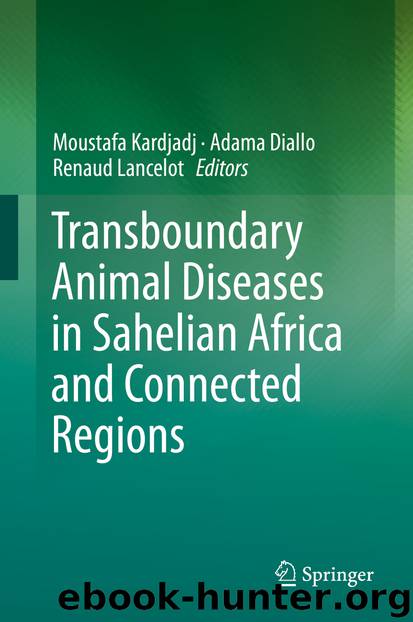Transboundary Animal Diseases in Sahelian Africa and Connected Regions by Moustafa Kardjadj & Adama Diallo & Renaud Lancelot

Author:Moustafa Kardjadj & Adama Diallo & Renaud Lancelot
Language: eng
Format: epub
ISBN: 9783030253851
Publisher: Springer International Publishing
Control and Eradication Strategy
The control and eventually its eradication are based on mass vaccination of small ruminant populations in endemic countries. It is estimated that a 70% post vaccination immunity rate PIR is needed in a given epidemiological unit to prevent PPR virus spread (OIE and FAO 2015). However, implementing mass vaccination is difficult and costly in smallholder farming systems with scattered livestock and limited facilities. Regarding this, controlling PPR is a special challenge in Sahelian Africa. Hammami et al. (2018) used a modeling approach to assess the effect of several variables on PIR in two contrasted smallholder farming systems: (1) goats reared in subhumid areas (ca. 900 mm of annual rainfall) with high reproduction, mortality, and offtake rates and (2) sheep reared in semiarid areas (ca. 250 mm of annual rainfall), with lower reproduction, offtake, and mortality rates. The PVIR dynamic was simulated over a 4-year vaccination program thus corresponding to a recommended duration for the control stage. Because of the huge difference in population dynamics, the annual vaccination campaign was made of a single round of vaccination in semiarid environment, and two rounds in subhumid area. The ability of different vaccination scenarios to reach the 70% PVIR was assessed throughout the program. The tested scenarios differed in (1) their overall schedule, (2) their delivery month, and (3) their vaccination coverage.
In sheep reared in semiarid areas, the vaccination month did affect the PVIR decay (best month for vaccination generally in September) though it did not in goats in subhumid regions. In both cases, the study highlighted (1) the importance of targeting the whole eligible population at least during the first 2 years of the vaccination program and (2) the importance of reaching a vaccination coverage as high as 80% of this population. This study confirmed the relevance of the vaccination schedules recommended by international organizations.
In Sahelian Africa and in the corresponding coastal areas of West Africa, there is strong evidence that PPRV transmission is intense everywhere from arid to humid agro-ecosystems. Therefore, in this area, there is no other option than mass vaccination, campaign coordinated at the regional level (Lancelot et al. 2014). However in other locations, the lack of knowledge about the transmission potential of PPRV may compromise eradication efforts. By fitting a metapopulation model simulating PPRV spread to the results of a nationwide serological survey in Ethiopia, Fournié et al. (2018) estimated the level of viral transmission in an endemic setting and the vaccination coverage required for elimination. Results suggest that the pastoral production system as a whole acts as a viral reservoir, from which PPRV spills over into the sedentary production system, where viral persistence is uncertain. Estimated levels of PPRV transmission indicate that viral spread could be prevented if the proportion of immune small ruminants is kept permanently above 37% in at least 71% of pastoral village populations. However, due to the high turnover of these populations, maintaining the fraction of immune animals above this threshold would require high vaccine coverage within villages and vaccination campaigns to be conducted annually.
Download
This site does not store any files on its server. We only index and link to content provided by other sites. Please contact the content providers to delete copyright contents if any and email us, we'll remove relevant links or contents immediately.
Periodization Training for Sports by Tudor Bompa(8168)
Why We Sleep: Unlocking the Power of Sleep and Dreams by Matthew Walker(6618)
Paper Towns by Green John(5086)
The Immortal Life of Henrietta Lacks by Rebecca Skloot(4523)
The Sports Rules Book by Human Kinetics(4288)
Dynamic Alignment Through Imagery by Eric Franklin(4115)
ACSM's Complete Guide to Fitness & Health by ACSM(3987)
Kaplan MCAT Organic Chemistry Review: Created for MCAT 2015 (Kaplan Test Prep) by Kaplan(3939)
Introduction to Kinesiology by Shirl J. Hoffman(3720)
Livewired by David Eagleman(3682)
The Death of the Heart by Elizabeth Bowen(3551)
The River of Consciousness by Oliver Sacks(3535)
Alchemy and Alchemists by C. J. S. Thompson(3447)
Bad Pharma by Ben Goldacre(3352)
Descartes' Error by Antonio Damasio(3229)
The Emperor of All Maladies: A Biography of Cancer by Siddhartha Mukherjee(3061)
The Gene: An Intimate History by Siddhartha Mukherjee(3046)
The Fate of Rome: Climate, Disease, and the End of an Empire (The Princeton History of the Ancient World) by Kyle Harper(3003)
Kaplan MCAT Behavioral Sciences Review: Created for MCAT 2015 (Kaplan Test Prep) by Kaplan(2935)
